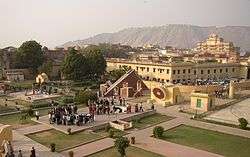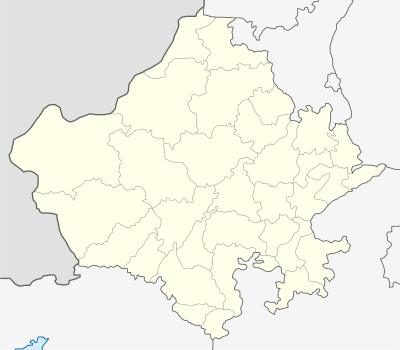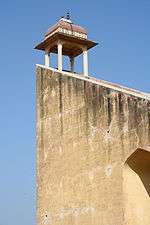Jantar Mantar, Jaipur
| Jantar Mantar, Jaipur | |
|---|---|
| Name as inscribed on the World Heritage List | |
 | |
| Type | Cultural, History |
| Criteria | iii, iv |
| Reference | 1338 |
| UNESCO region | South Asia |
| Inscription history | |
| Inscription | 2010 (34th Session) |
 Location of Jantar Mantar, Jaipur in India Rajasthan. | |
Coordinates: 26°55′29″N 75°49′28″E / 26.92472°N 75.82444°E The Jantar Mantar monument of Jaipur, Rajasthan is a collection of nineteen architectural astronomical instruments, built by the Rajput king Sawai Jai Singh, and completed in 1734 CE.[1][2] It features the world's largest stone sundial, and is a UNESCO World Heritage site.[1][3]
Located near City Palace and Hawa Mahal of Jaipur, the monument features masonry, stone and brass instruments that were built using astronomy and instrument design principles of ancient Hindu Sanskrit texts.[2][4] The instruments allow the observation of astronomical positions with the naked eye. The monument expresses architectural innovations, as well as the coming together of ideas from different religious and social beliefs in 18th century India.[1] The observatory is an example of the Ptolemaic positional astronomy which was shared by many civilizations.[1][2]
The monument features instruments operating in each of the three main classical celestial coordinate systems: the horizon-zenith local system, the equatorial system and the ecliptic system.[2] The Kapala Yantraprakara is one that works in two systems and allows transformation of the coordinates directly from one system to the other.[5]
The monument was damaged in the 19th century. Early restoration work was undertaken under the supervision of Major Arthur Garrett, a keen amateur astronomer, during his appointment as Assistant State Engineer for the Jaipur District.[6]
Name
The name is derived from jantar (yantra, Sanskrit: यन्त्र, "instrument, machine"), and mantar (from mantrana, Sanskrit: मन्त्रण, "consult, calculate").[7] Therefore Jantar Mantar literally means 'calculating instrument'.[3]
Description

The observatory consists of nineteen instruments for measuring time, predicting eclipses, tracking location of major stars as the earth orbits around the sun, ascertaining the declinations of planets, and determining the celestial altitudes and related ephemerides. The instruments are (alphabetical):[2]
- Chakra Yantra (four semicircular arcs on which a gnomon casts a shadow, thereby giving the declination of the Sun at four specified times of the day. This data corresponds to noon at four observatories around the world (Greenwich in UK, Zurich in Switzerland, Notke in Japan and Saitchen in the Pacific); this is equivalent of a wall of clocks registering local times in different parts of the world.)[8]
- Dakshin Bhitti Yantra (measures meridian, altitude and zenith distances of celestial bodies)[8]
- Digamsha Yantra (a pillar in the middle of two concentric outer circles, used to measure azimuth of the sun, and to calculate the time of sunrise and sunset forecasts)[9]
- Disha Yantra
- Dhruva Darshak Pattika (observe and find the location of pole star with respect to other celestial bodies)[9]
- Jai Prakash Yantra (two hemispherical bowl-based sundial with marked marble slabs that map inverted image of sky and allows the observer to move inside the instrument, measures altitudes, azimuths, hour angles and declinations)[2][8]
- Kapali Yantra (measures coordinates of celestial bodies in azimuth and equatorial systems, any point in sky can be visually transformed from one coordinate system to another)[5]
- Kanali Yantra
- Kranti Vritta Yantra (measures longitude and latitude of celestial bodies)
- Laghu Samrat Yantra (the smaller sundial at the monument, inclined at 27 degrees, to measure time, less accurate than Vrihat Samrat Yantra)[9]
- Misra Yantra
- Nadi Valaya Yantra (two sundials on different faces of the instrument, the two faces represent north and south hemispheres, the accuracy of the instrument in measuring the time is less than a minute)[9]
- Palbha Yantra
- Rama Yantra (a double cylinder instrument that measures azimuth and altitudes of celestial bodies)[8]
- Rashi Valaya Yantra (12 gnomon dials that measure ecliptic coordinates of stars, planets and all 12 constellation systems)
- Shastansh Yantra (next to Vrihat Samrat Yantra, this instrument is a 60 degree arc built in the meridian plane within a dark chamber. At noon, the sun's pinhole image falls on a scale below enabling the observer to measure the zenith distance, declination, and the diameter of the Sun.)[10]
- Unnatasha Yantra (a metal ring divided into four segments by horizontal and vertical lines, with a hole in the middle; the position and orientation of the instrument allows measurement of the altitude of celestial bodies)[9]
- Vrihat Samrat Yantra (world's largest gnomon sundial, measures time in intervals of 2 seconds using shadow cast from the sunlight)
- Yantra Raj Yantra (a 2.43-metre bronze astrolabe, one of the largest in the world, used only once a year, calculates the Hindu calendar)[11]
The Vrihat Samrat Yantra, which means the "great king of instruments", is 88 feet (27 m) high; its shadow tells the time of day. Its face is angled at 27 degrees, the latitude of Jaipur. The Hindu chhatri (small cupola) on top is used as a platform for announcing eclipses and the arrival of monsoons.

The instruments are in most cases huge structures. The scale to which they have been built has been alleged to increase their accuracy. However, the penumbra of the sun can be as wide as 30 mm, making the 1mm increments of the Samrat Yantra sundial devoid of any practical significance. Additionally, the masons constructing the instruments had insufficient experience with construction of this scale, and subsidence of the foundations has subsequently misaligned them. The samrat yantra, for instance, which is a sundial, can be used to tell the time to an accuracy of about two seconds in Jaipur local time.[12] The Giant Sundial, known as the Samrat Yantra (The Supreme Instrument) is one of the world's largest sundials, standing 27 metres tall.[13] Its shadow moves visibly at 1 mm per second, or roughly a hand's breadth (6 cm) every minute, which can be a profound experience to watch.
Materials of construction

Built from local stone and marble, each instrument carries an astronomical scale, generally marked on the marble inner lining. Bronze tablets, bricks and mortar were also employed in building the instruments in the monument spread over about 18,700 square metres.[2] It was in continuous use until about 1800, then fell in disuse and disrepair.[2] Restored again several times during the British colonial rule, particularly in 1902, the Jantar Mantar was declared a national monument in 1948. It was restored in 2006.[2] The restoration process in early 20th century replaced some of the original materials of construction with different materials.[2]
Jantar Mantar is managed under the Archeological Sites and Monuments Act of Rajasthan since 1961, and protected as a National Monument of Rajasthan since 1968.[14]
Theory
The Vedas mention astronomical terms, measurement of time and calendar, but do not mention any astronomical instruments.[4] The earliest discussion of astronomical instruments, gnomon and clepsydra, is found in the Vedangas, ancient Sanskrit texts.[4][15] The gnomon (called Shanku, शङ्कु)[16] found at Jantar Mantar monument is discussed in these 1st millennium BCE Vedangas and in many later texts such as the Katyayana sulbasutras.[4] Other discussions of astronomical instruments are found in Hinduism texts such as the 4th century BCE[15] Arthashastra, Buddhist texts such as Sardulakarna-avadana, and Jainism texts such as Surya-prajnapti. The theories behind the instruments are found in texts by the 5th century CE Aryabhatta, 6th century CE Brahmagupta and Varahamihira, 9th century Lalla, 11th century Sripati and Bhaskara. The texts of Bhaskara have dedicated chapters on instruments and he calls them Yantra-adhyaya.[4][15]
The theory of chakra-yantra, yasti-yantra, dhanur-yantra, kapala-yantra, nadivalaya-yantra, kartari-yantra and others are found in the ancient texts.[4]
Filming location
It was used as a filming location for the 2006 film The Fall as a maze.
Storm Thorgerson photographed the sundial for the cover of Shpongle's DVD, Live at the Roundhouse 2008.[17]
It was photographed by Julio Cortázar with the collaboration of Antonio Gálvez for the book Prosa del Observatorio (Editorial Lumen: Barcelona, 1972).
See also
References
- 1 2 3 4 "The Jantar Mantar, Jaipur - UNESCO World Heritage Centre". Whc.unesco.org. 2010-07-31. Retrieved 2012-11-11.
- 1 2 3 4 5 6 7 8 9 10 11 The Jantar Mantar at Jaipur, India Portal to the Heritage of Astronomy, in partnership with UNESCO World Heritage Site
- 1 2 Smithsonian. Timelines of Science. Penguin. p. 136. ISBN 978-1465414342.
- 1 2 3 4 5 6 Yukio Ohashi (Editor: H Selin) (1997). Encyclopaedia of the History of Science, Technology, and Medicine. Springer. pp. 83–86. ISBN 978-0792340669.
- 1 2 Sharma, VN (1991). "The Kapala Yantras of Sawai Jai Singh" (PDF). Indian Journal of History of Science. 26 (2): 209–216.
- ↑ Monthly Notices of the Royal Astronomical Society, Vol. 81, p. 257
- ↑ mantraNa, yantra. "Sanskrit - English Dictionary". Spoken Sanskrit Germany. Koln University. Retrieved 15 April 2015.
- 1 2 3 4 David Kelly (2011). Exploring Ancient Skies: A Survey of Ancient and Cultural Astronomy. Springer. p. 82. ISBN 978-1441976239.
- 1 2 3 4 5 Lindsay Brown (2008). Rajasthan, Delhi & Agra. p. 157. ISBN 978-1741046908.
- ↑ Andreas Volwahsen (2001). Cosmic architecture in India. Prestel. pp. 48–73. ISBN 978-3791325064.
- ↑ SC Bhatt (2006). Land and People of Indian States and Union Territories. p. 362. ISBN 978-8178353791.
- ↑ Barry Perlus. "Architecture in the Service of Science: The Astronomical Observatories of Jai Singh II" (PDF). Jantarmantar.org. Retrieved 2012-11-11.
- ↑ "Largest sundial world record".
- ↑ THE RAJASTHAN MONUMENTS ARCHAEOLOGICAL SITES AND ANTIQUITIES RULES, 1968
- 1 2 3 David Edwin Pingree (1981). A History of Indian Literature, Vol 6. Otto Harrassowitz Verlag. pp. 52–54. ISBN 978-3447021654.
- ↑ gnomon. "Sanskrit - English Dictionary". Spoken Sanskrit Germany. Koln University. Retrieved 15 April 2015.
- ↑ "Twisted Music". Twisted Music. 2009-10-23. Retrieved 2012-11-11.
Further reading
- Sharma, Virendra Nath and aditya sharma (1995). Sawai Jai Singh and his astronomy. Motilal Banarsidass Publishers Pvt. Ltd. ISBN 81-208-1256-5.
External links
| Wikimedia Commons has media related to Jantar Mantar (Jaipur). |
- Official website of Rajasthan government, India, Jantar Mantar
- Jantar Mantar - Section III Theory, Construction and Limitations, National University of Singapore
- Photos of Jantar Mantar
- Jantar Mantar (Jaipur)
- Jantar Mantar Articles and History
- Architecture in the Service of Science
